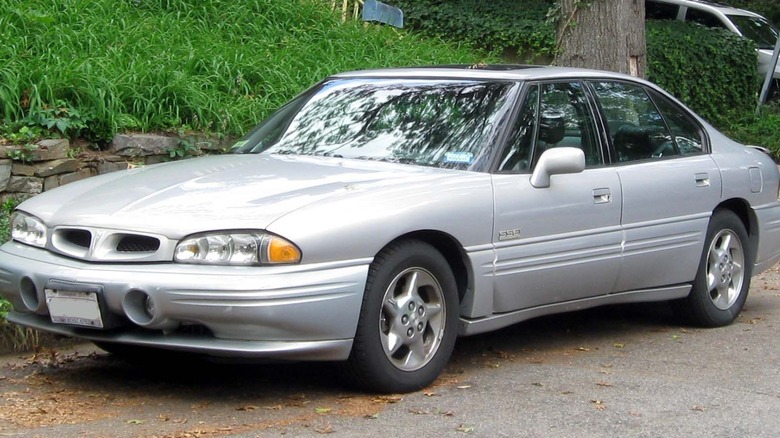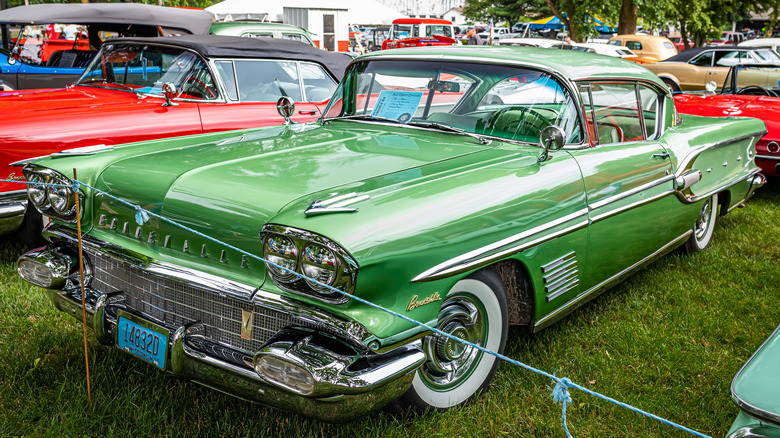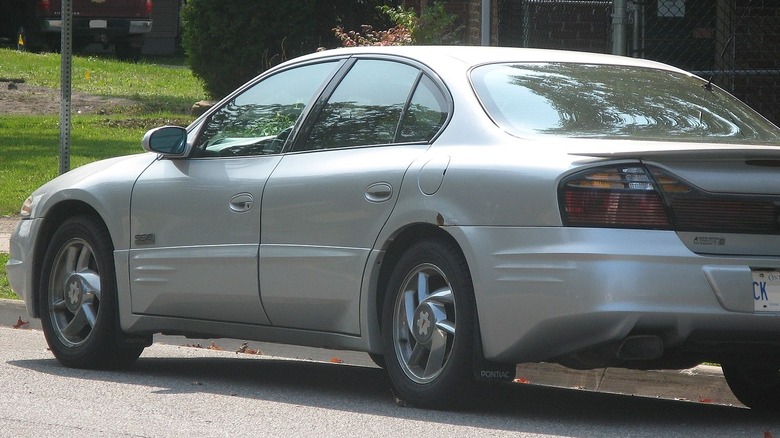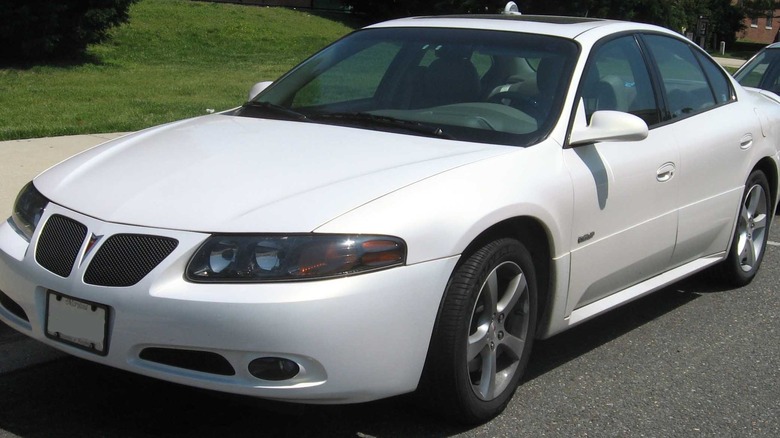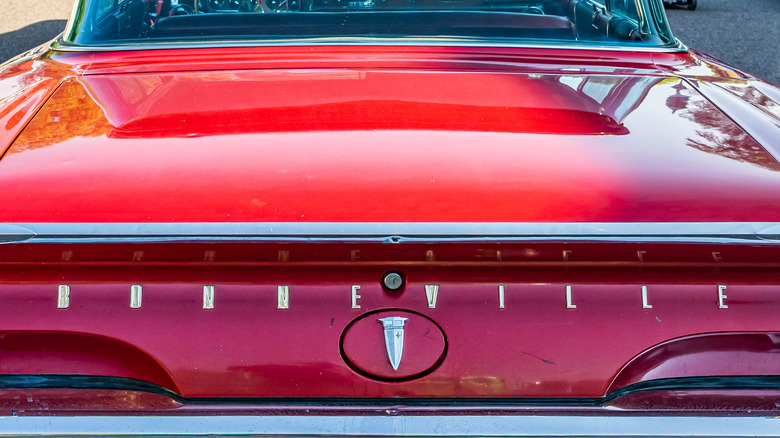Everything Pontiac Fans Should Know About The Bonneville SSEi
Pontiac's Bonneville got its name through in interesting convention. It was carefully chosen to reflect the company's high aspirations for it. As The New York Times reported, the model, which debuted in 1957, was named for David Abbott Jenkins' legendary racing career. The previous year, Jenkins and his son had shattered stock-car speed records in a Pontiac Series 860 at the annual Speed Week during Utah's Bonneville Salt Flats.
In honor of Jenkins' super-fast Class C record of 118.375 mph, the new model was dubbed the Bonneville in celebration of what he achieved behind the wheel of a Pontiac. Merv Jenkins said that "until my dad got hold of that Pontiac ... it was a car for retired ministers." But the Bonneville would foster its new image as a speed machine. To do so, it would need to maintain high performance as model years went by. This led to the Bonneville SSEi, perhaps the most formidable family member of all.
A high-performance trim introduced to the range some years after the Bonneville itself, the SSEi would establish itself as a cut above the base version, and evolve model year after model year. Let's look at the original Bonneville SSEi, its performance and capabilities, and its lifespan and legacy in the performance arena.
[Image by IFCAR via Wikimedia Commons | Cropped and Scaled | Public Domain]
The evolution of the Bonneville family
The auto industry is ever-changing and sometimes unpredictable. The bottom line is for manufacturers to cater as well as possible to the targeted audience, which can sometimes result in significant changes throughout a vehicle family's lifetime. With the venerable Bonneville, this was certainly the case.
The original 1957 Bonneville was a convertible exclusively. Before the decade was out, drivers had options for varieties besides, from the station wagon to the sedan. The latter wouldn't become the sole variety of Bonneville until 1987. The following year, the SSE debuted, featuring 160 hp and a top speed of 119 mph.
This was the new high-performance entry in the line, a vehicle family that survived the turbulent 1970s and the oil crises that emerged in that decade. Shortly after the SSE's introduction, the concept of a sportier Bonneville would be refined further. Adding the SSEi to the lineup was yet another step in that direction — one that would last until almost the very final days of the Bonneville's life. Though it didn't ultimately garner as much attention as it could have (an unfortunate trait of some Pontiac models), it would be a formidable addition to the market in more ways than one.
The first Bonneville SSEi
The SSEi made its debut in 1992. This model had a supercharged V6, capable of 205 hp with 2600 rpm of torque. It reached a maximum of around 128 mph in speed. Its 3.8l engine was the rising star of performance vehicles in the area, also seen in General Motors' Buick Park Avenue Ultra. With the base Bonneville hitting around 170 hp at the time, it was clear that the SSEi was devised as a significant advance worthy of its title's racing legacy.
During the year of the SSEi's debut, other trims were also available in the shape of the SE and SSE. All of which, of course, were four-door sedans equipped with the same 3.8-liter engine but lacked the supercharger — an industry element that was very much in a transformative state at the time with the advent of more practical centrifugal superchargers – impacted the performance of other models. The SE and SSE variants had 170 hp (4800 rpm) and the SSEi was slightly heavier than the SSE (3507 pounds to 3607 pounds), underlying the SSEi's position as a model heftier in both performance and physicality.
Almost a decade of future releases of the SSEi, as with the Bonneville more broadly, would only iterate slightly on the formula, retaining the supercharged 3.8 liter engine. The 2000 model year, however, marked quite a major departure for the model.
[Image by SsmIntrigue via Wikimedia Commons | Cropped and Scaled / CC BY-SA 4.0]
The Bonneville SSEi's 2000 transformation
Under the hood, the 2000 SSEi didn't change much across the last eight years, with 205 hp and a 17 city, 27 highway mpg economy competing with the likes of the Chevrolet Lumina (175 hp) and Volvo S70 (236 hp).
Pontiac's most luxurious Bonneville had been born from the company's desire to develop more of a speedy, powerful image, as Jenkins' performances on the Bonneville Salt Flats had demonstrated. Doing so, however, is a matter of more than just what's under the hood. It's also about raw aesthetics. Departing from tradition, the 2000 SSE lacked the sportier look that became synonymous with the SSEi model. This helped to set it apart in the Bonneville family, and it retained a suite of mod cons, including luxurious leather seats, up to three different sockets, and a streamlined yet sophisticated display system.
This year, the SSEi opened up customization options for drivers, including dispensing with the supercharger if preferred (it cost approximately $1,200, Car and Driver estimated at the time) and adding a sunroof. For the rest of the SSEi's life until the arrival of the GXP trim (pictured above), Pontiac would add such options for drivers.
[Image by IFCAR via Wikimedia Commons | Cropped and Scaled | Public Domain]
The final years of the SSEi, the Bonneville family, and Pontiac itself
The 2001 and 2002 years saw more cosmetic additions for the SSEi, including a wider color range. These years and the 2003 gave drivers more choice for wheels and the opportunity to add an XM radio to the entertainment mix. By 2003, Pontiac also included features like automatic dual zone air conditioning above and beyond its SE and SLE counterparts.
For the 2004 model, the high-performance trim would have a different labeling instead. The GXP, as it would be known, benefitted from the option of a V8 Northstar (it had been almost two decades since the Bonneville family last sported a V8 engine). That particular powerplant, standard issue on this version, offered up to 275 horsepower and torque of 300 lb.-ft. On top of that, the 2004 GXP was equipped with features such as UltraLux seat inserts, a unique red-and-white instrument panel and Stabilitrak technology that the SE and SLE missed out on.
With the GXP, as with the SSEi, the idea was seemingly comfort, performance, and practicality. Though this work was cut short by the end of the Bonneville program in 2005. The final fall of Pontiac itself followed in 2010 in the light of General Motors' financial woes. But the SSEi and the Bonneville family are still as fondly remembered by many as are David Abbott Jenkins' historic racing exploits that inspired their names.
